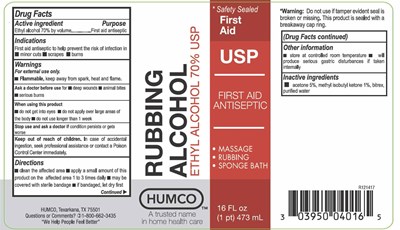Product Images Ethyl Rubbing Alcohol
View Photos of Packaging, Labels & Appearance
Product Label Images
The following 2 images provide visual information about the product associated with Ethyl Rubbing Alcohol NDC 0395-0040 by Humco Holding Group, Inc., such as packaging, labeling, and the appearance of the drug itself. This resource could be helpful for medical professionals, pharmacists, and patients seeking to verify medication information and ensure they have the correct product.
new label - ethyl alcoholl 70 new label

This is a drug facts label for an antiseptic solution containing 70% ethyl alcohol. It is intended for first aid use to prevent infections in minor cuts, burns, and scrapes. It is also flammable and should be kept away from heat and flame. The label provides directions for use and warnings against use with deep wounds, animal bites, and serious burns, as well as caution against application to large areas of the body or use for longer than 1 week. The inactive ingredients list includes acetone, methyl isobutyl ketone, bitrex, and purified water.*
Principal Display PanelNDC 0395-0040-16RUBBING ALCOHOLETHYL ALCOHOL 70%USPFirst Aid Antiseptic16 fl oz (1 pt) 473 mL - ethyl rubbing alcohol 01

This is the drug facts description for an Ethyl Rubbing Alcohol product. It contains 70% USP Ethyl Alcohol as the active ingredient and is primarily used to prevent infection in cuts, scrapes, and burns. It is meant for external use only and is flammable. If the tamper-evident seal is broken or missing, it should not be used. If there is a need to use the product for longer than 1 week, it is important to consult a doctor. If the product comes into contact with the eyes, wash them thoroughly. Ideally, it should be kept out of reach of children and used cautiously by pregnant or nursing women.*
* The product label images have been analyzed using a combination of traditional computing and machine learning techniques. It should be noted that the descriptions provided may not be entirely accurate as they are experimental in nature. Use the information in this page at your own discretion and risk.